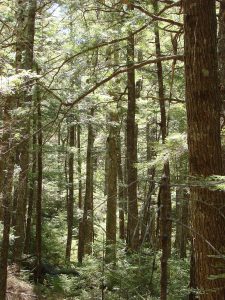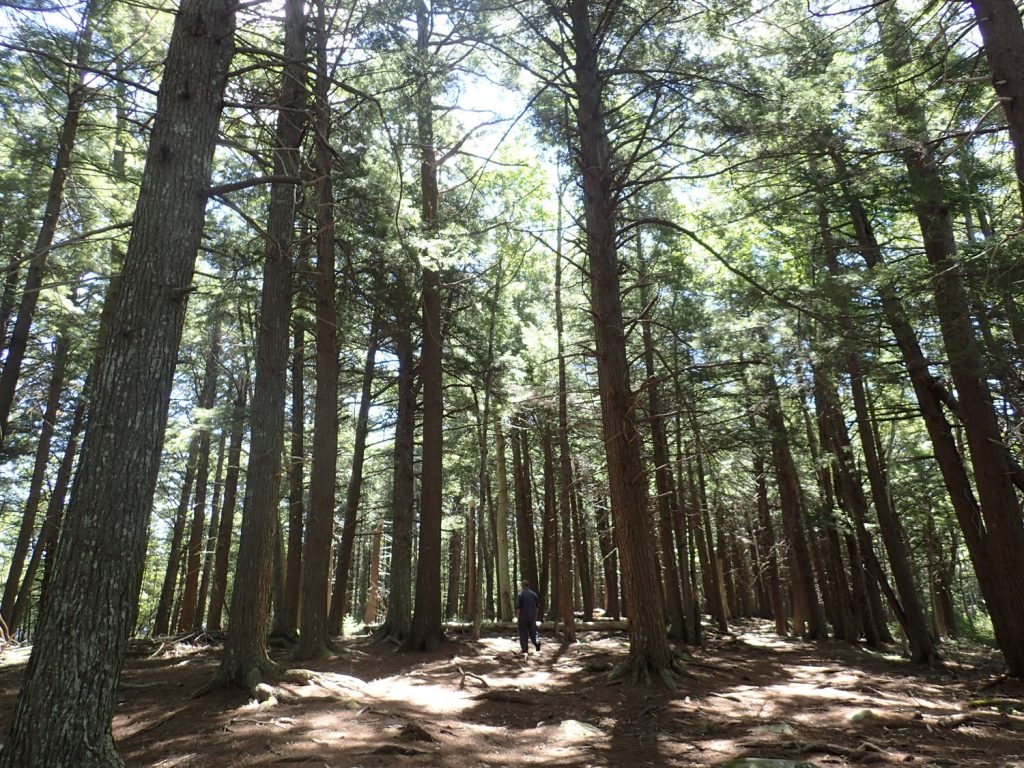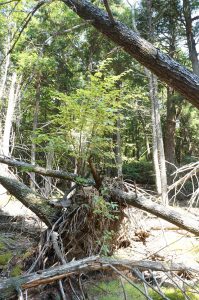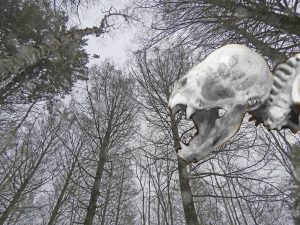
Contributed photo of hemlock stand in the Tusket ravaged by wooly adelgid, winter of 2017/2018.
Skull of vampire bat by Mokele on Wikipedia.
Click on images for larger versions
Perhaps the ghosts of the hemlock wooly adelgid in the form of those dead grey trees could have a benefit, which is to remind ‘adults’ of the costs of denying our real impacts on our natural world and we will begin, as ‘the kids’ are demanding, to take the radical steps necessary to save what we can.
A few days ago, I was given a lesson on how to look for early signs of the Hemlock Wooly Adelgid (HWA), aka the Hemlock Vampires.
Nova Scotians (and the Feds) were taken by surprise by this exotic pest which was first reported in in NA in Virginia is 1951 and is now found spread through 20 eastern states (Limbu et al, 2018).
In Canada, “prior to the discovery of HWA in Nova Scotia, small, localized HWA incursions were found in Ontario in 2012 and 2013… These populations were controlled by removal of the infested hemlock trees. Delimitation surveys have been ongoing at these locations and no further evidence of HWA has been detected since 2015.” [A separate strain of the pest occurs in British Columbia, where they “rarely cause significant damage”]
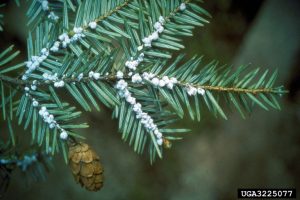
Hemlock Woolly Adelgid. “Their name comes from waxy white filaments they make to protect themselves from drying out. In a heavy infestation, hemlock trees can look gray from all the “wool” on twigs and branches. They can’t fly, but are spread by wind and also hitch rides on the feet of birds, which can carry hemlock wooly adelgids for long distances. These “hemlock vampires” were first discovered in 1951 in Virginia, and by 2005 had spread to fifteen other states.
Source: Paul Hetzler, Cornell Cooperative Extension
Photo source: Connecticut Agricultural Experiment Station, Bugwood.org
“In June 2017, established HWA populations were discovered in southwest Nova Scotia with evidence of tree decline and mortality… the fact that HWA populations have already established in southwest Nova Scotia and have caused tree mortality (CFIA, 2017), [suggests].. that HWA has persisted there for a number of years.” – Emilson and Stastny, 2019
So Nova Scotia is now Ground Zero for the spread of HWA in eastern Canada, a pest that has caused up to 100% hemlock mortality in some areas of the U.S. (lit reviewed in Emilson and Stastny, 2019).
What is being done in practice to limit spread of HWA in Nova Scotia?
The CFIA has issued a restriction on movement of the pest or a “regulated article” from the five counties in SW Nova Scotia (Annapolis, Digby, Yarmouth Shelburne, Queens) where it currently occurs. The regulations are said to be unclear and detrimental to some businesses.
I have been told but have not myself confirmed that exceptions are being granted and that infested hemlock is being moved to mills and/or permits (exceptions) are being given to move logs of other species from the affected area… if true, it is surely a recipe for accelerating spread of HWA.
In any case, there are few if any signs on roads or notifications in newspapers (try to find any), social media etc. and many if not most residents in areas where it is actively spreading remain oblivious to its spread, even to its presence in its earlier stages.
The time from initial infection to death of a tree can be as little as 3 years, so by the time one might recognize something gone awry, it is too late to do anything, except to remove the infected tree.
There are options for protecting some of these stately trees around residences that owners might consider; they are pricey (circa $100/tree, repeat every 5 years), and involve injecting some bad stuff (neonicotinoids) into the tree. Perhaps many owners would consider them but will not until it is too late because there is so little public awareness of the HWA. A suggestion: if you live anywhere in NS and want to keep a few trees, now is the time to deal with it.
”Don’t know though where to direct one to get the pertinent info, permits etc. There is a “a working group with CFIA, NSDNR, MTRI, CFS, Parks Canada, and a number of researchers”, but no website for that (apparently), and it seems there is no HWA Command and Control Centre or the equivalent.
In essence, we (Nova Scotians) are collectively, it seems, in a state of Hemlock Vampire Denial*.
_______
*Perhaps “largely oblivious to HWA” would be a more accurate description of where we are, “Denial” seemed more fitting for a Halloween post. Unfortunately, halloween will persist in the hemlock stands, minus the candy.
If we were to give much more rigorous attention to limiting movement of wood from infested areas and if we were to encourage and enable much more public participation in monitoring than is currently occurring, perhaps some local popuations of hemlock could be saved and perhaps it would buy some time to begin to test and introduce some of the more promising bio-control agents.
But overall, the picture does not look very hopeful. From a recent review:
Key challenges faced by HWA management in eastern Canada are due to uncertainties, short timelines and limited resources, and the unavailability of certain tactics. In particular, eradication, although potentially viable for new incursions, is confounded by the lack of a reliable low-density detection method to delimit the extent of an HWA infestation, and confirm the removal of the last individual. In addition, effectively slowing the spread of HWA via implementation of preventative regulations and increased education and outreach is constrained by the time and resources needed to create effective awareness and enforcement, along with HWA’s passive dispersal over long-distances and parthenogenetic reproduction. The suppression of HWA populations to reduce hemlock mortality is also impeded by the current lack of available biological control tactics for use against HWA in Canada. Finally, uncertainties around the nature of the site-specific ecosystems that will emerge following hemlock mortality, along with the unknown consequences for terrestrial and aquatic ecosystem services, habitats and food webs, complicate comparisons between a do-nothing strategy and an intervention strategy.
One sign that the professionals in the area do not have a lot of hope: I learned recently that seed is being collected for cryopreservation, I guess in the hope that hemlock might be re-introduced into NS sometime well after its (and the collectors’) demise.
HWA in Nova Scotia can be viewed as the result of two modern human activities: globalization and the spread of just about everything to everywhere; and anthropogenically-induced climate warming which has enabled HWA to extend its range further north.
Perhaps the ghosts of HWA in the form of those dead grey trees could have a benefit, which is to remind ‘adults’ of the costs of denying our real impacts on our natural world and we will begin, as ‘the kids’ are demanding, to take the radical steps necessary to save what we can.
I deal with my sadness around this issue by trying to document a little of what is before it becomes what was; and, like visiting an elder in a home when you know she is in her last days, I simply spend some quiet time with her.
After a while, she told me about the Acadian Forest Love Affair, and said that she would be OK if her beloved yellow birch were to take over many of the stands downed by HWA.
That raises an the issue we need to think about and discuss: how will we deal with forests that have been decimated by HWA?
Would we really need to ‘salvage’ all of the wood from dead trees or to conduct “pre-emptive logging” of hemlock?
Couldn’t we leave large blocks to nature to process, perhaps with a controlled burn where we are super-concerned about fire? We could then witness and learn from the inevitable succession, perhaps over as many as seven of our generations which would take us into the early 2200s*.
_______
*That’s about as far forward as we have to go back in time (1824) for the first suggestion that humans might be having a “greenhouse effect” on the Earth’s surface temperatures.
I hope so.
Who knows, maybe there will even be some HWA-resistant lines that survive – if we don’t cut them down pre-emptively.
LINKS
Hemlock Woolly Adelgid Management Plan for Canada
Information Report GLC-X-21. 2018. Emilson, C.; Bullas-Appleton, E.; McPhee, D.; Ryan, K.; Stastny, M.; Whitmore, M.; MacQuarrie, C.J.K. Natural Resources Canada, Canadian Forest Service. Information Report GLC-X-21. 26p.
For areas with HWA in Nova Scotia, an Infested Place Order has also been declared to control the movement of regulated articles (CFIA 2017b) and a firewood importation ban has been implemented by Parks Canada for Kejimkujik National Park. McClure (1990) noted comparable densities of HWA eggs on the trunks of associated hardwood species. Given that large‐scale harvesting operations are not currently restricted in forests with HWA, movement of HWA on the trunks of other associated tree species is still a potential dispersal pathway of concern. Additionally, risk of movement by humans undertaking recreational activities in infested areas is especially high during the months of March-July when eggs and crawlers are most abundant.
Identifying areas of high risk for HWA invasion will be critical to the success of monitoring and tracking efforts. Therefore, the lack of a complete hemlock inventory showing the location and quantity of hemlock in eastern Canada is one of the greatest barriers to successful management and control and one that needs to be addressed.
The current Canadian early detection survey protocol, modified from a US Department of Agriculture (USDA) Forest Service protocol (Costa and Onken 2006), is a visual
survey targeting nymphs, adults and white egg sacs and is ideally performed from March to May (CFIA 2018). Information including aerial photos, forest inventories, wind patterns, bird migratory routes and proximity to importers of hemlock nursery products and the eastern US (≤100km) can be used to select stands with a major component of hemlock and that are at least 4 ha in size for surveying.
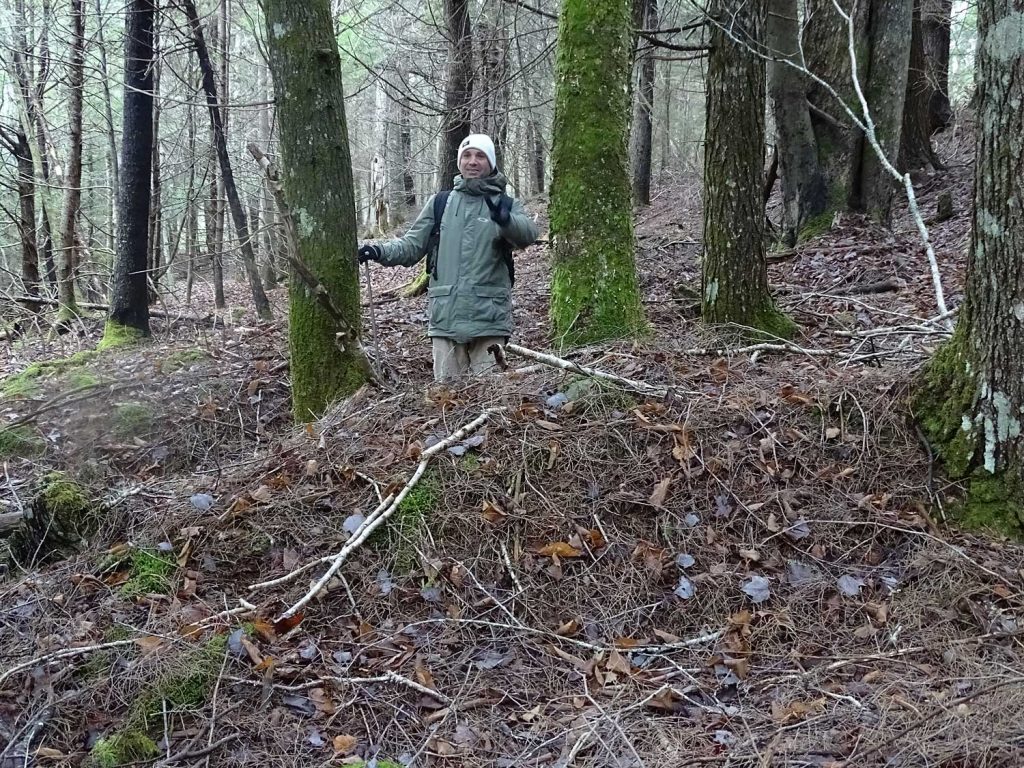
Pit and Mound topography in a patch of hemlock/yellow birch Old Growth by Sandy Lake (Bedford, NS) in 2018: the hemlock and yellow birch we see there today established on the remnants of a massive blowdown circa 155 years ago.
D-07-05: Phytosanitary requirements to prevent the introduction and spread of the Hemlock Woolly Adelgid (Adelges tsugae Annand) from the United States and within Canada
Canadian Food Inspection Agency
Questions and Answers: Hemlock Woolly Adelgid (Adelges tsugae) Detection in Nova Scotia
Canadian Food Inspection Agency
A decision framework for hemlock woolly adelgid management: Review of the most suitable strategies and tactics for eastern Canada
Caroline E. Emilsona and Michael Stastny in Forest Ecology and Management Volume 444, 15 July 2019, Pages 327-343
Highlights
•Hemlock is a foundation species that supports distinct forest ecosystems.
•The invasive hemlock woolly adelgid (HWA) has decimated hemlock in the eastern US.
•HWA continues to spread north and has begun causing hemlock mortality in Nova Scotia.
•We provide a decision framework to inform HWA management plans in eastern Canada.
•Current lack of HWA control highlights the importance of an ecosystem restoration plan.
The Past, Present, and Future of the Hemlock Woolly Adelgid (Adelges tsugae) and Its EcologicalInteractions with Eastern Hemlock (Tsuga canadensis) Forests
Aaron M. Ellison et al., 2018 in Insects 2018, 9, 172ff “: The nonnative hemlock woolly adelgid is steadily killing eastern hemlock trees in many parts of eastern North America. We summarize impacts of the adelgid on these forest foundation species; review previous models and analyses of adelgid spread dynamics; and examine how previous forecasts of adelgid spread and ecosystem dynamics compare with current conditions. The adelgid has reset successional sequences, homogenized biological diversity at landscape scales, altered hydrological dynamics, and changed forest stands from carbon sinks into carbon sources.”
Nova Scotia Hemlock Woolly Adelgid Update Western Woodland Conference, March 3, 2018
Slide set with life cycle diagrams etc.
New documentary on Hemlock Wooly Adelgid in Nova Scotia
Post on NSFN, Sep 1, 2018, with a link to a Video posted on YouTube by Soren Bondrup-Nielsen/Blomidon Field Naaturalists
Hemlock Woolly Adelgid is now in SW Nova Scotia
Post on NSFN Aug 6, 2017
Hemlock vampires are firmly established in southwest Nova Scotia
Post on NSFN Jan 10, 2018
Citizen scientists needed to detect hemlock woolly adelgid in South West Nova Scotia
Carla Allen in www.thevanguard.ca Jan 7, 2019
Potential Effects of Climate Change on Mortality of the Invasive Species Hemlock Woolly
Adelgid (Adelges tsugae) in Nova Scotia, Canada
Anna K. J. Irwin-Borg. Document prepared in partial fulfillment of the requirements for the degree of Bachelor of Science Dalhousie University.
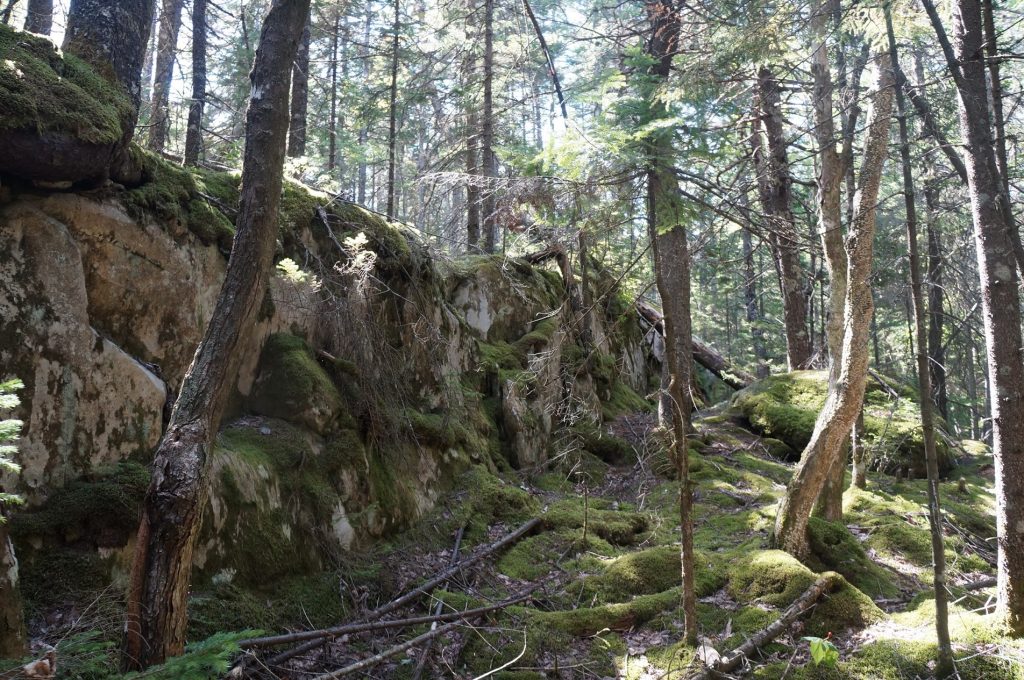
Hemlock dominated forest on moist rocky outcrops, Halifax Co. More pics here
St. Lawrence – Eastern Lake Ontario Partnership For Regional Invasive Species Management: Hemlock Woolly Adelgid
View article by Paul Hetzler on the same website for some optimism:
|
Healthy Hemlock Forests of the Maritimes
A Project on iNaturalist created by Matthew Smith, an ecologist for Kejimkujik National Park. “This project will track the location of hemlock stands throughout the Maritimes. Eastern Hemlock forests are endangered due to the presence of a sucking insect Hemlock Woolly Adelgid (HWA). In July 2017, HWA was observed in 5 counties (Yarmouth, Digby, Shelburne, Queens and Annapolis) in Southern Nova Scotia. This site will allow observers to submit reports of HWA and infestation level.”
Nova Scotia Pest Update
Nova Scotia Lands & Forestry 2 March 2019. Slides 16 to 22 are about HWA.
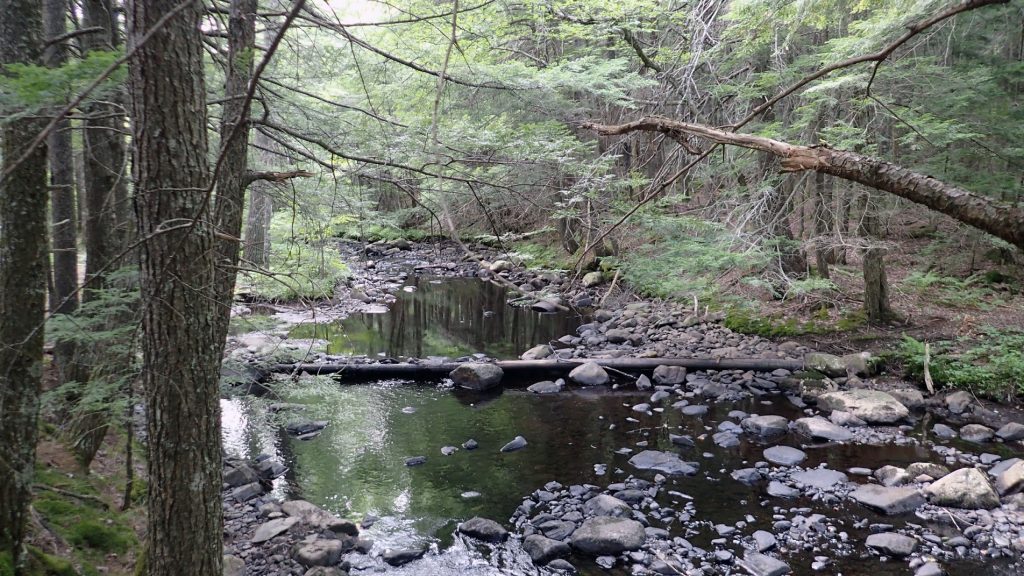
Hemlock-lined Peverill’s Brook (digger log installed by Sackville Rivers Association to improve habitat for salmon; view video)
——–
Comments
BW: Thanks so much for putting this post on the HWA together. There just isn’t enough information being put “out there” for the public to see, read, discuss. Agree — there’s obviously a problem with biosecurity and limiting movement of infected tree materials around the province. This needs to be dealt with – very strictly – but so far, it is not. All of us — everyone — should be aware of what HWA infestation looks like and be vigilant – watching for it on trees wherever we my be in NS. If it’s seen, it should be reported. If we are traveling into areas of Hemlock infected with HWA, we should be taking biosecurity measures to not spread it when we leave those areas. Agree, this is another example of “denial” until things are too late — of trying to close the gate after the horse has already run away. Also, this thing about trying to “salvage harvest” infected hemlock — it’s going to create a hell of a lot more trouble and loss than whatever bucks made from harvesting infected stands.

